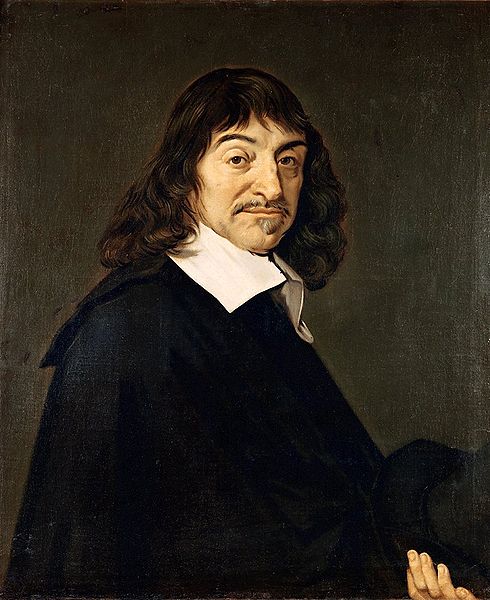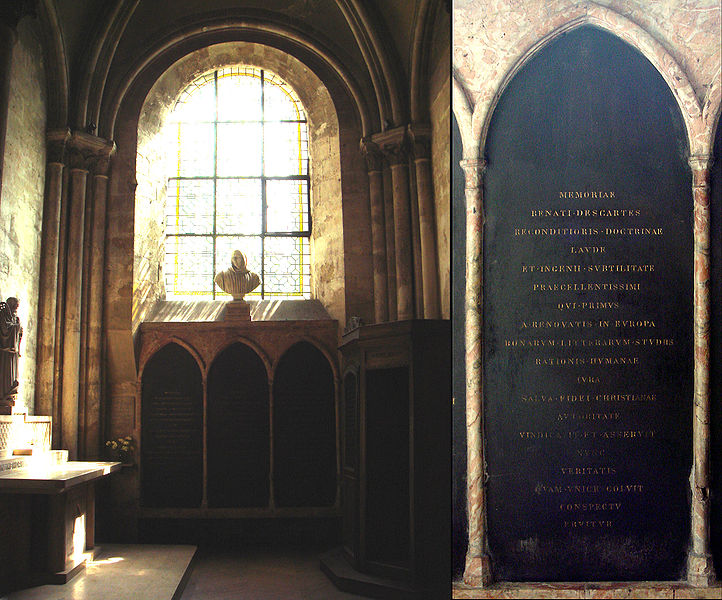<Back to Index>
- Philosopher, Mathematician and Physicist René Descartes, 1596
- Composer Franz Joseph Haydn, 1732
- First President of the Republic of Georgia Zviad Gamsakhurdia, 1939


René Descartes (31 March 1596 – 11 February 1650), also known as Renatus Cartesius (Latinized form), was a French philosopher, mathematician, physicist, and writer who spent most of his adult life in the Dutch Republic. He has been dubbed the "Father of Modern Philosophy", and much of subsequent Western philosophy is a response to his writings, which continue to be studied closely to this day. In particular, his Meditations on First Philosophy continues to be a standard text at most university philosophy departments. Descartes' influence in mathematics is also apparent, the Cartesian coordinate system — allowing geometric shapes to be expressed in algebraic equations—being named for him. He is credited as the father of analytical geometry. Descartes was also one of the key figures in the Scientific Revolution.
Descartes frequently sets his views apart from those of his predecessors. In the opening section of the Passions of the Soul, a treatise on the Early Modern version of what are now commonly called emotions, he goes so far as to assert that he will write on this topic "as if no one had written on these matters before". Many elements of his philosophy have precedents in late Aristotelianism, the revived Stoicism of the 16th century, or in earlier philosophers like St. Augustine. In his natural philosophy, he differs from the Schools on two major points: First, he rejects the analysis of corporeal substance into matter and form; second, he rejects any appeal to ends—divine or natural—in explaining natural phenomena. In his theology, he insists on the absolute freedom of God’s act of creation.
Descartes was a major figure in 17th-century continental rationalism, later advocated by Baruch Spinoza and Gottfried Leibniz, and opposed by the empiricist school of thought consisting of Hobbes, Locke, Berkeley, Jean-Jacques Rousseau, and Hume.
Leibniz, Spinoza and Descartes were all well versed in mathematics as
well as philosophy, and Descartes and Leibniz contributed greatly to
science as well. As the inventor of the Cartesian coordinate system, Descartes founded analytic geometry, the bridge between algebra and geometry, crucial to the discovery of infinitesimal calculus and analysis. He is best known for the philosophical statement "Cogito ergo sum", found in part IV of Discourse on the Method and §7 of part I of Principles of Philosophy. Descartes was born in La Haye en Touraine (now Descartes), Indre-et-Loire, France. When he was one year old, his mother Jeanne Brochard died of tuberculosis. His father Joachim was a member in the provincial parliament. Around the age of eleven, he entered the Jesuit Collège Royal Henry-Le-Grand at La Flèche. After graduation, he studied at the University of Poitiers, earning a Baccalauréat and Licence in law in 1616, in accordance with his father's wishes that he should become a lawyer. In the summer of 1618 he joined the army of Maurice of Nassau in the Dutch Republic. On 10 November 1618, while walking through Breda, Descartes met Isaac Beeckman,
who sparked his interest in mathematics and the new physics,
particularly the problem of the fall of heavy bodies. While in the
service of the Duke Maximilian of Bavaria, Descartes was present at the Battle of the White Mountain outside Prague, in November 1620. In 1622 he returned to France, and during the next few years spent time in Paris and other parts of Europe. He arrived in La Haye in 1623, selling all of his property, investing this remuneration in bonds which provided Descartes with a comfortable income for the rest of his life. Descartes was present at the siege of La Rochelle by Cardinal Richelieu in 1627. He returned to the Dutch Republic in 1628, where he lived until September 1649. In April 1629 he joined the University of Franeker and the next year, under the name "Poitevin", he enrolled at the Leiden University to study mathematics with Jacob Golius and astronomy with Martin Hortensius. In October 1630 he had a falling out with Beeckman, whom he accused of plagiarizing some of his ideas. In Amsterdam, he had a relationship with a servant girl, Helène Jans, with whom he had a daughter, Francine, who was born in 1635 in Deventer, at which time Descartes taught at the Utrecht University. Francine Descartes died in 1640 in Amersfoort. While in the Netherlands he changed his address frequently. Despite
these frequent moves he wrote all his major work during his 20 plus
years in the Netherlands, where he managed to revolutionize mathematics
and philosophy. In 1633, Galileo was condemned by the Roman Catholic Church, and Descartes abandoned plans to publish Treatise on the World,
his work of the previous four years. "Discourse on the Method" was
published in 1637. In it Descartes lays out four rules of thought,
meant to ensure that our knowledge rests upon a firm foundation. Descartes continued to publish works concerning both mathematics and philosophy for the rest of his life. In 1643, Cartesian philosophy was condemned at the University of Utrecht, and Descartes began his long correspondence with Princess Elisabeth of Bohemia. In 1647, he was awarded a pension by the King of France. Descartes was interviewed by Frans Burman at Egmond-Binnen in 1648. René Descartes died on 11 February 1650 in Stockholm, Sweden, where he had been invited as a teacher for Queen Christina of Sweden. In 1663, the Pope placed his works on the Index of Prohibited Books. As a Roman Catholic in a Protestant nation, he was interred in a graveyard mainly used for unbaptized infants in Adolf Fredriks kyrkan in Stockholm. Later, his remains were taken to France and buried in the Abbey of Saint-Germain-des-Prés in Paris. Although the National Convention in1792 had planned to transfer his remains to the Panthéon, they are, two centuries later, still resting between two other graves—those of the scholarly monks Jean Mabillon and Bernard de Montfaucon—in a chapel of the abbey. His memorial, erected in the 18th century, remains in the Swedish church. Descartes is often regarded as the first thinker to provide a philosophical framework for the natural sciences as these began to develop. In his Discourse on the Method,
he attempts to arrive at a fundamental set of principles that one can
know as true without any doubt. Descartes proceeds to construct a system of knowledge, discarding perception as unreliable and instead admitting only deduction as a method. In the third and fifth Meditation, he offers an ontological proof of a benevolent God (through both theontological argument and trademark argument).
In
Descartes' system, knowledge takes the form of ideas, and philosophical
investigation is the contemplation of these ideas. This concept would
influence subsequent internalist movements
as Descartes' epistemology requires that a connection made by conscious
awareness will distinguish knowledge from falsity. Descartes also wrote a response to skepticism about the existence of the external world. He argues that sensory perceptions come
to him involuntarily, and are not willed by him. They are external to
his senses, and according to Descartes, this is evidence of the
existence of something outside of his mind, and thus, an external
world. Descartes
was also known for his work in producing the Cartesian Theory of
Fallacies. This can be most easily explored using the statement: "This
statement is a lie." While it is most commonly referred to as a paradox,
the Cartesian Theory of Fallacies states that at any given time a
statement can be both true and false simultaneously because of its
contradictory nature. The statement is true in its fallacy. Descartes in his Passions of the Soul and The Description of the Human Body suggested that the body works like a machine, that it has the material properties of extension and motion, and that it follows the laws of physics. The mind (or soul), on the other hand, was described as a nonmaterial entity
that lacks extension and motion, and does not follow the laws of
physics. Descartes argued that only humans have minds, and that the
mind interacts with the body at the pineal gland. This form of dualism or
duality proposes that the mind controls the body, but that the body can
also influence the otherwise rational mind, such as when people act out
of passion. Most of the previous accounts of the relationship between
mind and body had been uni-directional. Descartes suggested that the pineal gland is
"the seat of the soul". Cartesian dualism set the agenda for philosophical discussion of the mind-body problem for
many years after Descartes' death. The question of how a nonmaterial
mind could influence a material body, without invoking supernatural
explanations, remains controversial to this day. Later
in correspondence with Princess Elisabeth of Bohemia, he admitted he
had no idea how the mind interacted with the body, abandoning the
concept of the pineal glands as connection. Descartes' theory provided the basis for the calculus of Newton and Leibniz, by applying infinitesimal calculus to the tangent line problem, thus permitting the evolution of that branch of modern mathematics. This appears even more astounding considering that the work was just intended as an example to his Discours de la méthode pour bien conduire sa raison, et chercher la verité dans les sciences (Discourse on the Method of Rightly Conducting the Reason, and Searching for Truth in the Sciences, better known under the shortened title Discours de la méthode; English, Discourse on the Method). Descartes' rule of signs is also a commonly used method to determine the number of positive and negative roots of a polynomial. Rene Descartes created analytic geometry, and discovered an early form of the law of conservation of momentum (the term momentum refers to the momentum of a force). He outlined his views on the universe in his Principles of Philosophy. Descartes also made contributions to the field of optics. He showed by using geometric construction and the law of refraction (also
known as Descartes' law or more commonly Snell's law, who discovered it
16 years earlier) that the angular radius of a rainbow is 42 degrees
(i.e., the angle subtended at the eye by the edge of the rainbow and
the ray passing from the sun through the rainbow's centre is 42°). He also independently discovered the law of reflection, and his essay on optics was the first published mention of this law. One of Descartes most enduring legacies was his development of Cartesian geometry which uses algebra to describe geometry. He also "invented", the notation which uses superscripts to show the powers or exponents. The first notations of exponents were given by Franciscus Vieta in 1591, after whom the scottish mathematician James Hume, wrote A{iv} and the french Herigone : A4.